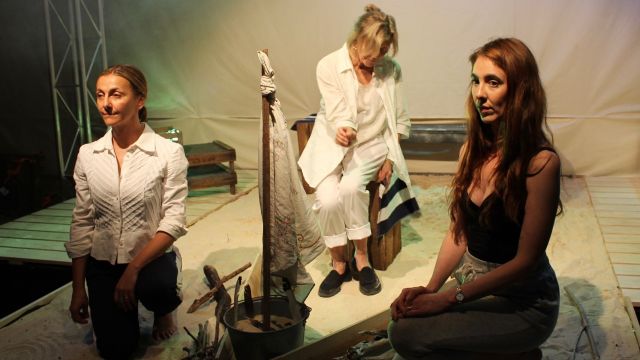Zander’s Boat
‘We tell stories in Shetland – we’re good at that. It’s a place full of darkness… Stories can fill that dark with light and banish the shadows hiding there, waiting.’ So Edith (Suzanne Heywood, also the director) tells us at the start of this play. And indeed, it is a play of stories, told in monologues which run parallel, never interweaving or intersecting, told by three women of three generations of the Shetland Isles. But it begins with an evocation of the myths and mysteries of the Shetlands, tales of seals – or ‘zelkies’ – that can shed their skins and assume human form… and then it segues into the individual tales of each of three women.
Motherhood, isolation and the ‘masculine’ culture of the place are the central components. As islanders, the beach and the sea are central loci for these women’s stories, subtly suggested by William Atkinson’s simple set of sand and driftwood and his lighting design of milky, misty light that breaks to a warmer glow as each of our three, in turn and turnabout, becomes the storyteller.

Edith is the eldest, in her 60s, at risk of being consumed by regret. She adored her little boy Zander, especially when they dreamed together on the beach of building a boat and sailing together far away. But Zander grew up and Edith found she disliked the boy-become-man – and now, tragically, it is too late. Marie (a fierce performance from Gabriella Rose-Carter), in her 40s, tells a not unfamiliar story that does at times resort to cliché: a life of frustration and dissatisfaction, of some ineffable something always out of reach. Her marriage, her career, the brief wonderful but dead-end affair, none have been enough – and yet what would be enough? Marie can’t say – and so, how could she even begin to achieve it?
Sylvie (Liza Meagher), in her 20s, has a story that has the most events – rich in detail – and humour. It tells of her marriage to Paul, his blaming her for their having no children – and what she did about that. Ms Meagher is so bright she almost glows (but perhaps too early and too often in her narrative) and the ‘happy ending’ – which is to say, she wins – is one of a deception that can’t guarantee a future.
All three actors tell their character’s stories with passion, emotion and a fine sense of pace, and of light and shade. Director Susan Heywood has certainly ensured that. We are engaged with the fate of each woman: we understand Edith’s feelings and struggle not to judge her; we recognise Marie’s bitterness and feel for her being stuck with her unfulfilled sense of herself (too late now for her too); and we share Sylvie’s anger at the injustice of her husband (and his mates) even if we’re ambivalent about her ‘religious’ solution. (In this ‘masculine culture’ we would not be surprised at some vicious domestic violence to come…)
 As stories per se, they are good enough, enhanced by being so well told by the actors, but playwright Grace Barnes employs some sleight of hand, wrapping the stories in the Shetlands’ silence, darkness, myths and magic. But in fact, those atmospheric specifics turn out to have very little to do with stories that could, indeed, happen anywhere. Do these stories ‘fill that dark with light’? I think not. We’ve forgotten about the dark.
As stories per se, they are good enough, enhanced by being so well told by the actors, but playwright Grace Barnes employs some sleight of hand, wrapping the stories in the Shetlands’ silence, darkness, myths and magic. But in fact, those atmospheric specifics turn out to have very little to do with stories that could, indeed, happen anywhere. Do these stories ‘fill that dark with light’? I think not. We’ve forgotten about the dark.
Marie doesn’t even live there anymore – and her mother, at sixty-four, escapes to see the world. Sylvie and her husband Paul honeymoon in Italy – and return there… Only with Edith, yearning over a past than cannot be changed, do we feel the location suffusing her sad tale. In addition, as often happens with a ‘play’ that is in fact made up of monologues addressed directly to the audience, we might catch ourselves yearning for the characters to talk to each other. Don’t they, after all, live in the same place, this place of darkness, isolation and patriarchal dominance, pass each other in the street and, in fact, know each other’s story? That could lead to the drama of interaction, of judgement, of interpretation – but that would be another play, and one shouldn’t ask for another play, should one?
Michael Brindley
Subscribe to our E-Newsletter, buy our latest print edition or find a Performing Arts book at Book Nook.

